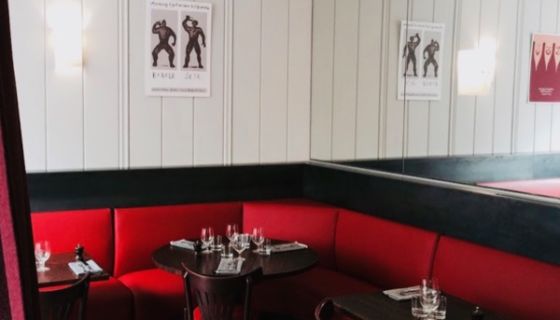The website of Amarante, a restaurant in Paris’s 12th arrondissement close to Bastille, opens with a warning from its chef/proprietor, Christophe Philippe.
‘To avoid any mistakes', he explains, ‘this restaurant is for you if you like your meat with a little fat on it; if you enjoy your fish and your meat not overcooked; if you like butter; if you have a healthy appetite; and if you don’t enjoy Coca Cola’. These were at least five good reasons for making a booking in my opinion.
When we finally arrived, almost 30 minutes late thanks to gilets jaunes demonstrations, hungry and thirsty, wet and windswept, our first reaction was one of surprise. How could anyone make a success out of such an awkward L-shaped space?
By the restaurant’s entrance there is room for only a few tables in front of the mirrored wall shown above right, an awkward space barely improved by a few prints. The bar is to the right and then a few more tables run down what feels like a corridor en route to a glass-enclosed wine cellar (a huge inducement to drink) and the kitchens with a lavatory at the far end of it. It was only later that the importance of this passageway became obvious.
The restaurant’s menu also opens with an honest statement from Philippe: ‘A small team means short hours’ before listing their opening hours for lunch and dinner, just Friday to Tuesday. This weekly routine leaves Philippe free to pursue his other passion – opera.
The restaurant’s layout initially seemed unconducive to running a successful restaurant, but the tables and chairs are comfortable, not too close together, and the acoustics are good despite the absence of linen tablecloths. Quite soon the workings of the space become obvious.
The room is the right size to allow one waiter to look after all the tables. Once the menu was opened, Philippe’s cooking style was clearly apparent. ‘Ah, real food', remarked my Parisian friend.
The menu opened with a soup, as every restaurant should surely offer in winter, in this case of pumpkin with crisp bacon, and ended with four desserts. This document also includes the wine list, heavily influenced by natural wines, but not exclusively so and we ended up drinking extremely well.
Amarante’s modus operandi became obvious once our order was taken. There is no inputting into a computer terminal. Rather Philippe appears and takes the order from the waiter, reading it as he retreats into the kitchen.
Philippe is quite a sight. Broad rather than tall and dressed in a black, short-sleeved T-shirt and black trousers, with an apricot scarf tied loosely around his neck and sporting green Crocs, he looks quite the chef. My late father, who told me never to trust a skinny chef, would have said that we could not have been in better hands.
And so it was to prove. Our first courses, which ranged from a piece of foie gras to a very porky terrine to a plate of the thinnest slices of calves’ tongue served alongside a well-dressed salad and some powerful mayonnaise, were copious. With this we drank a bottle of fine 2016 Chablis L’Humeur du Temps from Alice and Olivier de Moor (€55).
The four of us followed this with a bottle of sunshine, a 2014 Château Simone from Provençe (€40) that suited a wide range of main courses that were distinguished by an unannounced bonus. My sole, our friend’s guinea fowl, and her husband’s second pork dish were not only very well cooked but served alongside perfect accompaniments. Chickpea fries with my sole, which I reluctantly had to hand round the table; carrots, boiled and then smothered in butter with the pork; and cabbage cooked with just the right amount of vinegar and water to render it confited alongside the de-boned guinea fowl.
The same element of surprise surrounded Philippe’s list of desserts, virtually all described on the menu as ‘not too sweet'. But it was their portion size that was another distinguishing factor – in the slices of pineapple lightly sautéed in rich Bordier butter, and in a twist on a crème brûlée with added lemon that justified its menu description of ‘sufficiently acid but comfortably fruity’. With one coffee, I happily paid a bill of €284.50.
As we were leaving, my friend, who remembers eating here when the restaurant was known as Sainte Amarante 30 years ago, asked Philippe how he had come to own it. ‘It was four years ago when at the end of service I got a phone call to let me know that the restaurant had been placed into receivership and was therefore for sale.
‘I consulted my old friend Rodolph Paquin, now the chef at le Repaire de Cartouche, but who had once cooked here and he encouraged me to come and have a look. I had to decide immediately whether I wanted it. It was midnight and the interior looked very grim but I said yes. I put all my savings into renovating the restaurant and all that I have learnt into the menu and the wine list.’
Philippe, now 39, was first apprenticed at the age of 13, before moving to Paris and working in a series of very fine French establishments. The opening sentence of Amarante’s menu reads ‘Cuisine et vins de France’.
Here, both are in the best of hands.
Amarante 4 rue Biscornet, Paris 75012: tel +33 1 07 67 33 21 25













